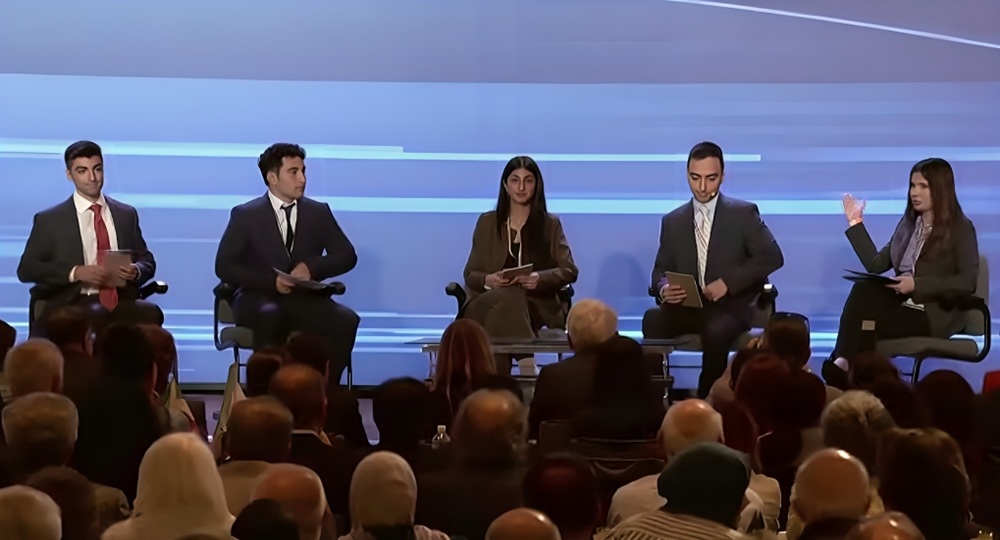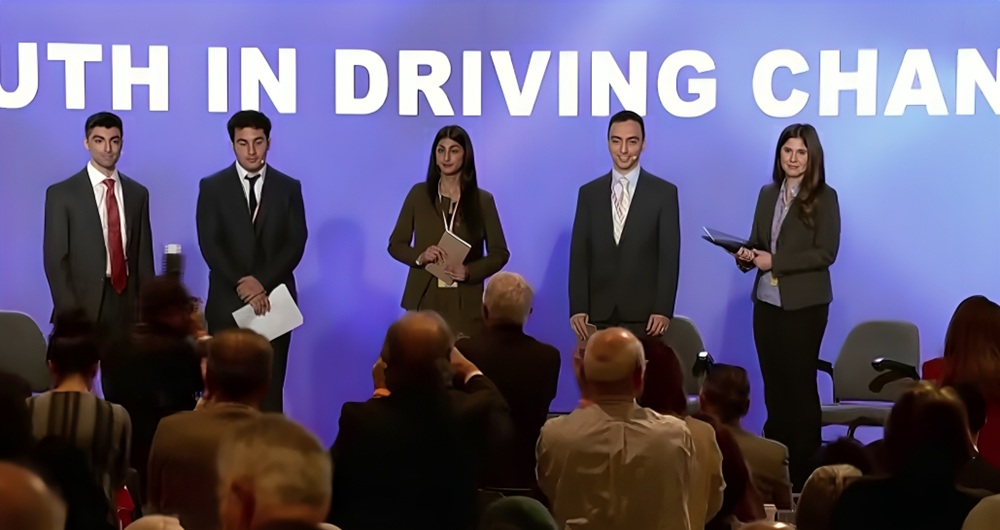
WASHINGTON, DC — The fourth session of the Free Iran Convention 2025, “The Power of Youth in Driving Change in Iran,” spotlighted Iran’s new generation as the central engine of the country’s freedom movement. From students and activists risking everything inside Iran to young professionals shaping policy, law, technology, and media abroad, the panel highlighted how Gen-Z courage, digital organizing, and global advocacy are redefining Iran’s political landscape. The discussion underscored that Iran’s youth—modern, connected, and fearless—are not only resisting repression but actively building the foundations for a democratic transition.
Panel moderator Nicole Shariati, a cybersecurity consultant from Denver and daughter of a former political prisoner, opened the fourth panel by grounding the conversation in both personal testimony and national struggle. Her father, she said, was imprisoned “for daring to speak the truth,” and she viewed her presence onstage as a continuation of his fight—and that of thousands whose sacrifices must never be forgotten.
Shariati described a regime that has relied on “fear, humiliation, and bloodshed” to try to break Iran’s youth. Yet, she said, the strategy has failed: “This brave, relentless generation refuses to surrender their future.” Despite shuttered universities, censorship, internet shutdowns, and violent crackdowns, young Iranians continue organizing, connecting, and resisting—often at extraordinary personal risk. “Their fearlessness,” she said, “is what terrifies the regime the most.”
She praised the MEK-affiliated Resistance Units as “the beating heart of this movement,” agile networks inside Iran that defy tyranny with creativity and courage. Abroad, young Iranians amplify these voices, making the struggle both national and global.
Iran’s youth, she concluded, have turned “pain into power, oppression into organization, and fear into fire,” forming the backbone of a democratic future.
Panel 4 is currently underway: The Power of Youth in Driving Change in Iran pic.twitter.com/wI5Ob3NrKT
— OIAC: Organization of Iranian American Communities (@OrgIAC) November 15, 2025
Mohammadreza Hesami, a senior medical dosimetrist who spent his adolescence in Iran, offered a raw and deeply personal account of what it feels like to grow up under a system designed to suffocate ambition. He began by asking the audience to consider the simplest hopes of any young person: “You want to be the best version of yourself… you want your nation to grow with you.” But in Iran, he said, those natural aspirations collide immediately with a regime that cares less about nurturing talent than policing conformity. “What they care about is how you dress, how you present yourself… what ideology you follow,” he explained.
Hesami said that the youth quickly learn that the regime is not interested in their dreams but in creating “subordinates that follow their rule.” Living under such conditions “felt like we were in a prison,” he said, recalling how limited the options became: accept humiliation and imposed poverty, flee the country, or fight back.
Pressed by moderator Nicole Shariati on why the regime relentlessly suppresses the youth, Hesami said the answer is fear. “The moment people don’t feel afraid anymore is the moment the regime has to answer serious questions,” he said. He cited imprisoned students Ali Younesi and Amir Hossein Moradi, and 22-year-old Ehsan Faridi—sentenced to death for supporting the MEK—as examples of a system terrified of independent ideas.
“The regime hasn’t failed at suppression,” Hesami warned. “They fear a generation that no longer believes in them.”
Washington- #FreeIranConvention2025 – Panel Discussion on Iranian Youth
“Why are young Iranians committed to regime change as opposed to incremental social and economic progress?”#NCRIAlternative #Iran pic.twitter.com/du9a2aM4HK— Firouz Mahvi (@FirouzMahvi) November 15, 2025
Mahrana “Mickey” Mohammadi, a J.D. candidate at Penn State Dickinson Law and active campus leader, spoke with conviction about how the MEK’s youth-centered roadmap can transform Iran’s future. Reflecting on the recent youth gathering in Paris, she described the atmosphere as “incredibly motivating and refreshing,” crediting Maryam Rajavi for articulating a clear and actionable plan for empowerment.
Mohammadi outlined the plan’s core pillars, beginning with dismantling the IRGC’s vast economic monopolies—structures she said have “strangled the economic potential of the youth.” Reclaiming these stolen assets and redirecting them into a national youth entrepreneurship fund, she argued, would unlock innovation, independence, and opportunity. Restoring free and open universities is another essential element. Campuses, she said, must once again become “centers of thought rather than tools of ideological control,” where students can think critically, collaborate, and build scientific and civic institutions.
She emphasized that guaranteeing women’s leadership is “absolutely essential,” noting that repealing compulsory hijab laws and all degrading regulations would establish genuine equality and inclusivity.
When asked which part of Maryam Rajavi’s Ten-Point Plan she found most significant, Mohammadi highlighted the creation of an independent judiciary. As a law student, she stressed that the rule of law is the backbone of any democracy—and that Iran’s regime has long weaponized its courts to silence dissent. She argued that a secular, rights-based legal system is the only way to ensure impartial governance, freedom of expression, and true justice for all.
“Why are young Iranians committed to regime change as opposed to incremental social and economic progress?”
Panel 4 | #FreeIranConvention2025 pic.twitter.com/tiSHGjQhX2
— OIAC: Organization of Iranian American Communities (@OrgIAC) November 15, 2025
Ryan Nasir, a computer science student and R&D intern from San Diego, offered a detailed and forceful explanation of why Resistance Units have become the defining force of youth-led activism in Iran. He described these units—comprised of nurses, students, workers, doctors, and young people across all 31 provinces—as “the tip of the spear of society,” deeply embedded in daily life and acting as the front line of defiance in a country where minors are executed at the highest per-capita rate in the world. Despite mass arrests—more than 3,600 during the 2022 uprising alone—Nasir emphasized that their numbers continue to grow, expanding into a nationwide network that gives people hope in “a land full of darkness.”
Ryan stressed that the acts carried out by Resistance Units, such as writing slogans on walls or striking at centers of repression, represent far more than symbolic gestures. “While we may see the final result as just a slogan,” he said, “it shows that someone was willing to stand up… that the regime is not ten feet tall.” Their open, public messages of support for the MEK and NCRI—sometimes filmed in broad daylight in Tehran—are, he argued, powerful evidence of a dictatorship losing its grip.
Responding to how the Resistance Units connect with the NCRI abroad, Nasir said the relationship is “a synergy built over decades of sacrifice.” The units keep the flame alive inside Iran, he explained, while the NCRI protects and amplifies it internationally. The foundation laid by the MEK and NCRI—from the 1988 massacre to the struggles of Camp Ashraf—has shaped the discipline and resolve of today’s youth activists.
This continuity of vision, he concluded, is what will ultimately pave the road to a “free, democratic, and secular republic of Iran.”
Seena Saiedian, a J.D. candidate at the University of Virginia School of Law and a Karsh-Dillard Scholar, delivered one of the panel’s most comprehensive analyses of why Iran’s youth overwhelmingly support regime change rather than gradual reform. He began by emphasizing that this demand is not made lightly: “Regime change is a serious inquiry,” he said, one that carries immense risks borne directly by the current generation inside Iran.
Saiedian explained that young Iranians—educated, ambitious, and globally connected—have known nothing but repression. They face crippling inflation, bleak job prospects, suffocating surveillance by the MOIS, and a state that imprisons students like Ali Younesi and Amirhossein Moradi for the “thoughtcrime” of supporting the MEK. After decades of failed promises from so-called moderates, he argued, the youth understand that no meaningful progress can emerge from within the system. Each new “reformist” presidency has delivered only more executions, more censorship, and more brutality. As he described, every major protest—from 2009 to 2017 to 2022—may begin with a specific grievance, but “very quickly… radicalizes into a nationwide call” targeting the regime itself.
What sustains this courage, he said, is the knowledge that a viable alternative exists: the NCRI and the MEK. Their decades-long commitment to democracy, their organizational capacity, and their ability to provide structure and hope give young Iranians confidence that they are not resisting alone— they are part of a national movement with a real platform and a clear plan.
When asked why the MEK resonates so strongly with young Iranians, Saiedian stressed three qualities required of any real transitional alternative: a principled commitment to democracy, organizational capacity, and institutional guardrails for free elections. “The only movement that meets these criteria,” he argued, “is the MEK.”
He underscored that the MEK’s credibility comes from action, not rhetoric. From the moment Khomeini rose to power in 1979, the MEK rejected theological dictatorship and insisted on popular sovereignty—an act of defiance that led to relentless persecution: the 1988 massacre of 30,000 political prisoners, repeated attacks on unarmed residents of Camp Ashraf, and even the 2018 foiled bombing plot targeting NCRI’s global gathering in Paris. These events, he said, reveal the regime’s fear: “Why else would they risk an international catastrophe? Because they are afraid of the MEK.”
Saiedian contrasted this with “fake opposition movements”—figures who, he argued, emerge only during uprisings to promote themselves without offering coherent platforms or democratic principles. The youth, he insisted, are not interested in returning to monarchy or trading one autocracy for another. “Iranians do not want to go back. They want to go forward,” he said.
In closing, Saiedian emphasized that each uprising grows “more radical, more widespread,” because the youth now believe not only that change is necessary—but that a democratic future is truly within reach.


